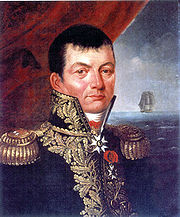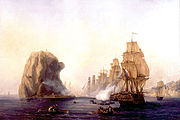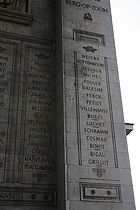
Julien Cosmao
Encyclopedia

Châteaulin
Châteaulin is a commune in the Finistère department in the region of Brittany in north-western France. It is a sub-prefecture of the department.-Geography:...
, Finistère
Finistère
Finistère is a département of France, in the extreme west of Brittany.-History:The name Finistère derives from the Latin Finis Terræ, meaning end of the earth, and may be compared with Land's End on the opposite side of the English Channel...
, 27 November 1761 - Brest
Brest, France
Brest is a city in the Finistère department in Brittany in northwestern France. Located in a sheltered position not far from the western tip of the Breton peninsula, and the western extremity of metropolitan France, Brest is an important harbour and the second French military port after Toulon...
, 17 February 1825) was a French Navy officer, admiral, and hero of the Battle of Trafalgar
Battle of Trafalgar
The Battle of Trafalgar was a sea battle fought between the British Royal Navy and the combined fleets of the French Navy and Spanish Navy, during the War of the Third Coalition of the Napoleonic Wars ....
.
Early career
Completing his studies in Châteaulin, young Cosmao-Kerjulien joined the French Royal Navy in 1776, against his parents' will. He served in the Aigrette in the Caraibs. Back to BrestBrest, France
Brest is a city in the Finistère department in Brittany in northwestern France. Located in a sheltered position not far from the western tip of the Breton peninsula, and the western extremity of metropolitan France, Brest is an important harbour and the second French military port after Toulon...
in 1778, he served on the Oiseau with Corentin de Leissegues. In September, after the beginning of the American Revolutionary War
American Revolutionary War
The American Revolutionary War , the American War of Independence, or simply the Revolutionary War, began as a war between the Kingdom of Great Britain and thirteen British colonies in North America, and ended in a global war between several European great powers.The war was the result of the...
, he served on the Nymphe, taking part in two battles against English privateer
Privateer
A privateer is a private person or ship authorized by a government by letters of marque to attack foreign shipping during wartime. Privateering was a way of mobilizing armed ships and sailors without having to spend public money or commit naval officers...
s, near Bordeaux
Bordeaux
Bordeaux is a port city on the Garonne River in the Gironde department in southwestern France.The Bordeaux-Arcachon-Libourne metropolitan area, has a population of 1,010,000 and constitutes the sixth-largest urban area in France. It is the capital of the Aquitaine region, as well as the prefecture...
and Belle-Isle.
Between January 1779 and April 1781, he served in Guyana abord the brig
Brig
A brig is a sailing vessel with two square-rigged masts. During the Age of Sail, brigs were seen as fast and manoeuvrable and were used as both naval warships and merchant vessels. They were especially popular in the 18th and early 19th centuries...
Hirondelle, fighting two more English privateers and capturing two East Indiamen. He was promoted to Lieutenant of an auxiliary frigate in September 1781. He served successively aboard the Pégase (February 1782) and the Protecteur (March) before taking command of the Fluyt
Fluyt
A fluyt, fluit, or flute is a Dutch type of sailing vessel originally designed as a dedicated cargo vessel. Originating from the Netherlands in the 16th century, the vessel was designed to facilitate transoceanic delivery with the maximum of space and crew efficiency...
Fidèle in Terre Neuve from May 1783 to April 1784. In January 1785 he served on the Lourde, on the Vigilante on October and the Dorade in April 1786. He was made a sub-lieutenant on a ship of the line in March 1786.
In September 1787, he was given command of the brig
Brig
A brig is a sailing vessel with two square-rigged masts. During the Age of Sail, brigs were seen as fast and manoeuvrable and were used as both naval warships and merchant vessels. They were especially popular in the 18th and early 19th centuries...
Vaneau, and of the Boulonnaise for November 1787 to March 1790. From October 1790 to January 1791, he was first officer abord the Précieuse.
From February 1791, he served aboard the Orion of the squadron of Laurent Jean François Truguet
Laurent Jean François Truguet
Laurent Truguet was a French admiral.-Youth up to the Revolution:Of arisocratic origins, and the son of a chef d'escadre, Laurent de Truguet entered the...
in Toulon
Toulon
Toulon is a town in southern France and a large military harbor on the Mediterranean coast, with a major French naval base. Located in the Provence-Alpes-Côte-d'Azur region, Toulon is the capital of the Var department in the former province of Provence....
. He was made ship of the line full lieutenant in January 1792, and received command of the corvette
Corvette
A corvette is a small, maneuverable, lightly armed warship, originally smaller than a frigate and larger than a coastal patrol craft or fast attack craft , although many recent designs resemble frigates in size and role...
Sincère in April. He took part in the landing at Cagliari
Cagliari
Cagliari is the capital of the island of Sardinia, a region of Italy. Cagliari's Sardinian name Casteddu literally means castle. It has about 156,000 inhabitants, or about 480,000 including the outlying townships : Elmas, Assemini, Capoterra, Selargius, Sestu, Monserrato, Quartucciu, Quartu...
in January 1793.
Captain
In the context of the lack of qualified officers due to the RevolutionFrench Revolution
The French Revolution , sometimes distinguished as the 'Great French Revolution' , was a period of radical social and political upheaval in France and Europe. The absolute monarchy that had ruled France for centuries collapsed in three years...
, he was made Capitaine de Vaisseau in April 1793, serving aboard the , the Centaure and the Duguay-Trouin
HMS Implacable (1805)
HMS Implacable was a 74-gun third rate of the Royal Navy. She was originally the French Navy's Téméraire-class ship of the line Duguay-Trouin, launched in 1800....
, under Rear-Admiral Trogoff de Kerlessy.
In December 1794 he was transferred to the squadron commanded by Admiral Pierre Martin
Pierre Martin (French Navy officer)
Admiral Pierre Martin was a French Navy officer and admiral.- Youth :Pierre Martin was born to a Canadian family of Louisbourg. In 1759, his family fled to Rochefort as his hometown was taken by the British during the Seven Years' War.Martin served as an apprentice on the fluit Saint Esprit...
, where he commanded the 80-gun ship of the line . On 10 June 1795, he captured the English frigate Alceste, and took part in the Battle of Cape Noli in March 1795 (the French and the English both lost two ships of the line) and of Cape Frejus
Naval Battle of Hyères Islands
The Naval Battle of Hyères Islands was fought on 13 July 1795 off the Hyères Islands, a group of islands off the French Mediterranean coast, about 25 km east of Toulon. The battle was fought between the van of a British fleet chasing the French squadron, and the French rear...
(17 French ships of the line against 23 English; the French lost the 74-gun Alcide
French ship Alcide (1782)
The Alcide was a 74-gun Pégase class ship of the line of the French Navy, launched in 1782.In 1782, she took part in the American war of Independence in De Grasse's fleet....
).
In June 1797, he was made chief of division, commanding the Jemmapes
French ship Jemmapes (1794)
The Jemmapes was a Téméraire-class 74-gun ship of the line of the French Navy.Laid down as Alexandre, she was renamed Jemmapes on 7 January 1793 in honour of the Battle of Jemappes. She took part in the Atlantic campaign of May 1794 and ultimately in the Glorious First of June...
in the Mediterranean. From 1801 to 1803, he served under Dordelin in Saint-Domingue
Saint-Domingue
The labour for these plantations was provided by an estimated 790,000 African slaves . Between 1764 and 1771, the average annual importation of slaves varied between 10,000-15,000; by 1786 it was about 28,000, and from 1787 onward, the colony received more than 40,000 slaves a year...
, commanding the , the Alliance and the .

French ship Pluton (1804)
Pluton was a 74-gun French ship of the line built at Toulon.It took part in the Battle of Trafalgar under Captain Julien Cosmao escaped to Cádiz with other ships. Two days later, on 23 October 1805, she was the flagship of the counter-attack from Cádiz, together with Indomptable, Neptune, Rayo, and...
in the squadron of Admiral Villeneuve
Pierre-Charles Villeneuve
Pierre-Charles-Jean-Baptiste-Silvestre de Villeneuve was a French naval officer during the Napoleonic Wars. He was in command of the French and Spanish fleets defeated by Nelson at the Battle of Trafalgar....
in Toulon. He accompanied the squadron to the Caraibs in its seizing of the English fortress
Battle of Diamond Rock
The Battle of Diamond Rock took place between 31 May and 2 June 1805 during the Napoleonic Wars. It was an attempt by Franco-Spanish force despatched under Captain Julien Cosmao to retake Diamond Rock, at the entrance to the bay leading to Fort-de-France, from the British forces that had occupied...
of the Diamond Rock
Diamond Rock
Diamond Rock is a 175 meter high basalt island located south of Fort-de-France, the main port of the Caribbean island of Martinique. The uninhabited island is about three kilometers from Pointe Diamant. The island gets its name from the reflections that its sides cast at certain hours of the day,...
, 6 nautical miles (11 km) away from Martinique
Martinique
Martinique is an island in the eastern Caribbean Sea, with a land area of . Like Guadeloupe, it is an overseas region of France, consisting of a single overseas department. To the northwest lies Dominica, to the south St Lucia, and to the southeast Barbados...
. Back to Europe, he took part in the Battle of Cape Finisterre
Battle of Cape Finisterre (1805)
In the Battle of Cape Finisterre off Galicia, Spain, the British fleet under Admiral Robert Calder fought an indecisive naval battle against the Combined Franco-Spanish fleet which was returning from the West Indies...
, on 22 July, saving one Spanish ship which had been cut off for a time by the British.
Battle of Trafalgar
At the Battle of TrafalgarBattle of Trafalgar
The Battle of Trafalgar was a sea battle fought between the British Royal Navy and the combined fleets of the French Navy and Spanish Navy, during the War of the Third Coalition of the Napoleonic Wars ....
, Pluton was part of the reconnaissance squadron created by Villeneuve and commanded by Spanish Admiral Gravina. She followed the in the line of battle, in the rear. When Admiral Collingwood
Cuthbert Collingwood, 1st Baron Collingwood
Vice Admiral Cuthbert Collingwood, 1st Baron Collingwood was an admiral of the Royal Navy, notable as a partner with Lord Nelson in several of the British victories of the Napoleonic Wars, and frequently as Nelson's successor in commands.-Early years:Collingwood was born in Newcastle upon Tyne...
attacked,Pluton opened fire on , then manoeuvered in order to block HMS Mars
HMS Mars (1794)
HMS Mars was a 74-gun third-rate ship of the line of the Royal Navy, launched on 25 October 1794 at Deptford Dockyard.-Career:In the early part of the French Revolutionary Wars she was assigned to the Channel Fleet. In 1797 under Captain Alexander Hood she was prominent in the Spithead mutiny...
, damaged her with artillery fire and attempted to board and seize her. However, the arrival of in her stern
Stern
The stern is the rear or aft-most part of a ship or boat, technically defined as the area built up over the sternpost, extending upwards from the counter rail to the taffrail. The stern lies opposite of the bow, the foremost part of a ship. Originally, the term only referred to the aft port section...
forced her to turn. She engaged , already damaged by the fire of Fougueux; again another English ship, , forced her to disengage. She then helped the surrounded of Gravina, and succeeded in freeing her.
However, at this point, the battle was already lost for the French. At sunset, five French ships ( , , , and and six Spanish ships tried to return to Cádiz
Cádiz
Cadiz is a city and port in southwestern Spain. It is the capital of the homonymous province, one of eight which make up the autonomous community of Andalusia....
, under dying Admiral Gravina. On 23 October, Cosmao, as the most senior officer present, took command of the squadron, and set back to sea with five ships: Pluton, Héros, Neptune, San Francisco de Asis, and Rayo
Spanish ship Rayo (1751)
The Rayo was an 80-gun ship of the line of the Spanish Navy. As was traditional for Spanish ships not named after a saint, its dedicatory name was San Pedro Apóstol. It fought at and was wrecked in the storm that followed.- External links :**...
. He managed to retake Neptuno
Spanish ship Neptuno (1795)
Neptuno was an 80-gun Montañes-class ship of the line of the Spanish Navy. She was built in 1795 and took part in the French Revolutionary and Napoleonic Wars. She fought with the Franco-Spanish fleet in the battle of Trafalgar, and was wrecked in its aftermath.Neptuno was built at Ferrol and...
and Santa Ana, as well as to force the English to scuttle a number of their prizes. Neptuno and Rayo sank during the journey back and the Indomptable was wrecked with the loss of over a thousand men.
Late career
Cosmao-Kerjulien was made Rear Admiral on 29 May 1806. He took command of a division of the French Mediterranean Fleet, under GanteaumeHonoré Joseph Antoine Ganteaume
Count Honoré Joseph Antoine Ganteaume was a French admiral.Ganteaume was born to a family of merchant sailors, and sailed on a dozen commercial cruises in his youth...
from 1807. he took part in operations to resupply Corfu and to the landing in Sicily. His 4 ships, having sustained damage, retreated to Taranto.
In late 1809, Ganteaume
Honoré Joseph Antoine Ganteaume
Count Honoré Joseph Antoine Ganteaume was a French admiral.Ganteaume was born to a family of merchant sailors, and sailed on a dozen commercial cruises in his youth...
was organising reinforcements to Barcelona. Cosmao set his flag on and took command of a squadron comprising , , and , as well as the frigates and , and a dozen of transports. The fleet departed Toulon on 24 April 1809, and returned on 1 May without incident.
Cosmao was made Baron
Baron
Baron is a title of nobility. The word baron comes from Old French baron, itself from Old High German and Latin baro meaning " man, warrior"; it merged with cognate Old English beorn meaning "nobleman"...
in 1810. In August 1811, he served under Admiral Missiessy in the Escaut Squadron, commanding a division, with his flag in the ship-of-the-line Tilsit.
In 1813 he returned to the Mediterranean Fleet, where he commanded a 5-ship division, with his flag on the . On 5 November 1813, he saved the 74-gun and the frigates Pénélope and Melpomène, under Vice-Admiral Emeriau, which were surrounded by superior English forces.

During the first restoration, in April 1814, Cosmao-Kerjulien received command of the Mediterranean Fleet, and was made a Knight in the Order of Saint Louis
Order of Saint Louis
The Royal and Military Order of Saint Louis was a military Order of Chivalry founded on 5 April 1693 by Louis XIV and named after Saint Louis . It was intended as a reward for exceptional officers, and is notable as the first decoration that could be granted to non-nobles...
. In 1815,upon the Emperor's brief return to power, he rallied to Napoleon, who made him préfet maritime
Préfet Maritime
The Préfet Maritime is a servant of the French State who exercises authority over the sea in one particular region . As a civil servant, he reports to the Prime Minister...
of Brest in March, and Peer of France
Peerage of France
The Peerage of France was a distinction within the French nobility which appeared in the Middle Ages. It was abolished in 1789 during the French Revolution, but it reappeared in 1814 at the time of the Bourbon Restoration which followed the fall of the First French Empire...
in June, right before the Battle of Waterloo
Battle of Waterloo
The Battle of Waterloo was fought on Sunday 18 June 1815 near Waterloo in present-day Belgium, then part of the United Kingdom of the Netherlands...
.
Cosmao-Kerjulien was retired on 1 January 1816, and for one year he did not receive a pension. At the time of his retirement, he was 55, with 25 year in campaigns, and 11 battles without once being wounded or captured. He died at 64, on 17 February 1825.
Five paintings of him can be seen in the town house of his home town of Châteaulin, in the Finistère
Finistère
Finistère is a département of France, in the extreme west of Brittany.-History:The name Finistère derives from the Latin Finis Terræ, meaning end of the earth, and may be compared with Land's End on the opposite side of the English Channel...
.
Honours

- Cosmao's name is engraved on the Arc de TriompheArc de Triomphe-The design:The astylar design is by Jean Chalgrin , in the Neoclassical version of ancient Roman architecture . Major academic sculptors of France are represented in the sculpture of the Arc de Triomphe: Jean-Pierre Cortot; François Rude; Antoine Étex; James Pradier and Philippe Joseph Henri Lemaire...
in Paris. - Légion d'Honneur from 7 April 1812
- chevalier de Saint-Louis from 5 July 1814
- Pair de France

